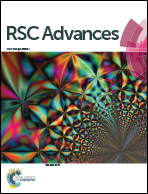The role of H3PO4 in the preparation of activated carbon from NaOH-treated rice husk residue
Abstract
The preparation of activated carbon from rice husk residue using H3PO4 as activation agent was studied. The samples were characterized by elemental analysis, N2 adsorption–desorption, scanning electron microscopy (SEM), X-ray diffraction (XRD), Fourier transform infrared spectroscopy (FT-IR), temperature programmed decomposition-mass spectra (TPD-MS), thermogravimetric analysis (TGA) and X-ray photoelectron spectroscopy (XPS). The role of H3PO4 in the activation process was discussed. A maximum surface area of 1016 m2 g−1 was obtained under the optimized conditions, that is, a base treated solid material to H3PO4 mass ratio of 1 : 2, an activation temperature of 500 °C and an activation time of 1 h. H3PO4 might act as a catalyst which facilitates the release of CO2, an oxidant which reacts with carbon after dehydration, and a reagent which enters AC through C–O–P bonds.


 Please wait while we load your content...
Please wait while we load your content...